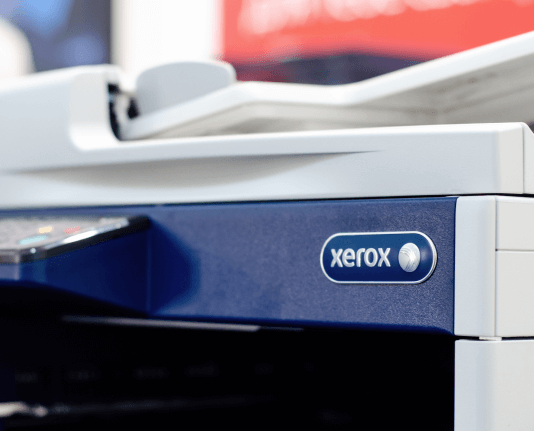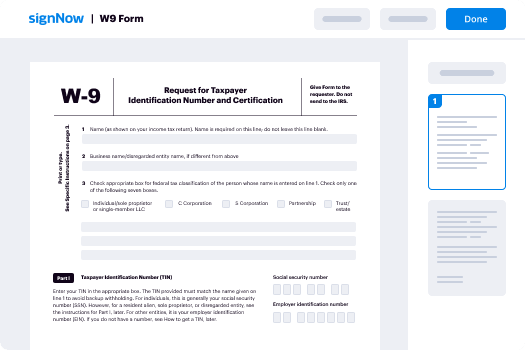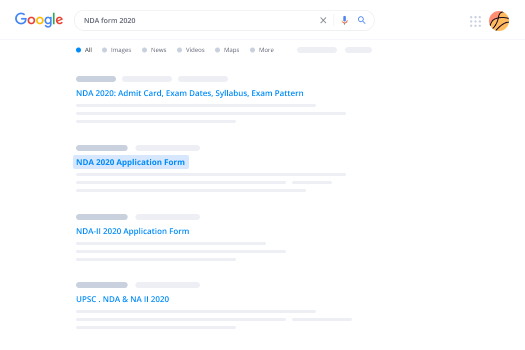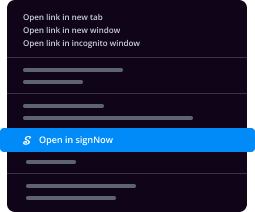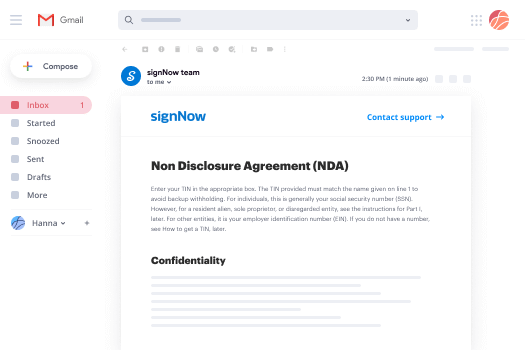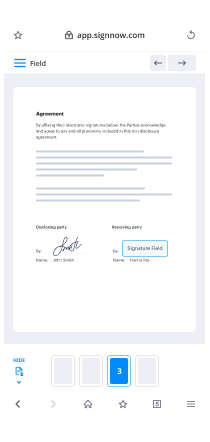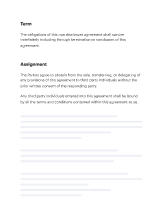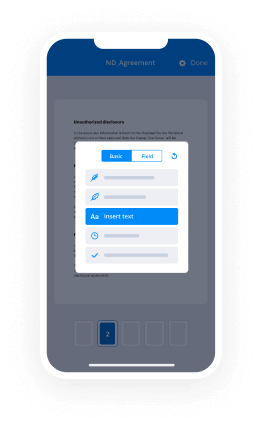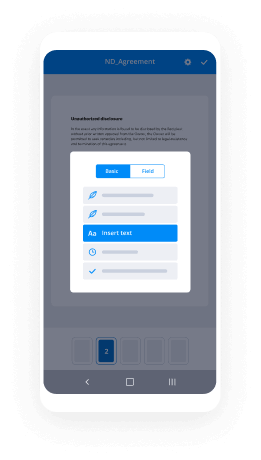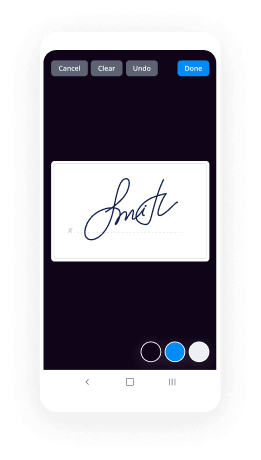eSign Word for IT Easy
Make the most out of your eSignature workflows with airSlate SignNow
Extensive suite of eSignature tools
Discover the easiest way to eSign Word for IT Easy with our powerful tools that go beyond eSignature. Sign documents and collect data, signatures, and payments from other parties from a single solution.
Robust integration and API capabilities
Enable the airSlate SignNow API and supercharge your workspace systems with eSignature tools. Streamline data routing and record updates with out-of-the-box integrations.
Advanced security and compliance
Set up your eSignature workflows while staying compliant with major eSignature, data protection, and eCommerce laws. Use airSlate SignNow to make every interaction with a document secure and compliant.
Various collaboration tools
Make communication and interaction within your team more transparent and effective. Accomplish more with minimal efforts on your side and add value to the business.
Enjoyable and stress-free signing experience
Delight your partners and employees with a straightforward way of signing documents. Make document approval flexible and precise.
Extensive support
Explore a range of video tutorials and guides on how to eSign Word for IT Easy. Get all the help you need from our dedicated support team.
Keep your eSignature workflows on track
Make the signing process more streamlined and uniform
Take control of every aspect of the document execution process. eSign, send out for signature, manage, route, and save your documents in a single secure solution.
Add and collect signatures from anywhere
Let your customers and your team stay connected even when offline. Access airSlate SignNow to eSign Word for IT Easy from any platform or device: your laptop, mobile phone, or tablet.
Ensure error-free results with reusable templates
Templatize frequently used documents to save time and reduce the risk of common errors when sending out copies for signing.
Stay compliant and secure when eSigning
Use airSlate SignNow to eSign Word for IT Easy and ensure the integrity and security of your data at every step of the document execution cycle.
Enjoy the ease of setup and onboarding process
Have your eSignature workflow up and running in minutes. Take advantage of numerous detailed guides and tutorials, or contact our dedicated support team to make the most out of the airSlate SignNow functionality.
Benefit from integrations and API for maximum efficiency
Integrate with a rich selection of productivity and data storage tools. Create a more encrypted and seamless signing experience with the airSlate SignNow API.
Collect signatures
24x
faster
Reduce costs by
$30
per document
Save up to
40h
per employee / month
Our user reviews speak for themselves






Advantages of airSlate SignNow Simplified
In terms of handling documents and signatures, airSlate SignNow provides a straightforward solution for organizations. This platform enables you to effortlessly send and eSign documents, guaranteeing a seamless workflow. With its user-friendly interface and extensive features, you can boost your efficiency while reducing expenses.
Utilizing airSlate SignNow is straightforward
- Launch your browser and head to the airSlate SignNow site.
- Register for a complimentary trial or log in if you already possess an account.
- Upload the document you need to sign or wish to dispatch for signatures.
- If you intend to reuse this document, save it as a template.
- Access your document and make any necessary modifications, such as including fillable fields or adding specific details.
- Sign the document and add signature fields for your recipients.
- Click 'Continue' to set up and dispatch your eSignature invitation.
Employing airSlate SignNow offers a variety of advantages, making document management more straightforward and effective. With its robust feature set, a signNow return on investment can be anticipated, especially for smaller and medium-sized enterprises.
Eager to optimize your document signing procedure? Experience airSlate SignNow today and see how simple it is to manage your documents and signatures effortlessly!
How it works
Browse for word easy
Customize and eSign it
Send it for signing
Rate your experience
-
Best ROI. Our customers achieve an average 7x ROI within the first six months.
-
Scales with your use cases. From SMBs to mid-market, airSlate SignNow delivers results for businesses of all sizes.
-
Intuitive UI and API. Sign and send documents from your apps in minutes.
A smarter way to work: —how to industry sign banking integrate
FAQs
-
How does airSlate SignNow make signing documents word easy?
airSlate SignNow simplifies the document signing process, making it word easy for users to send and eSign documents seamlessly. With an intuitive interface, you can quickly upload files, add signers, and track the signing status without any technical hurdles.
-
What are the pricing options for airSlate SignNow?
airSlate SignNow offers various pricing plans tailored to fit different business needs, making it word easy for teams of all sizes to find a suitable option. From individual plans to enterprise solutions, you can select a plan that provides the necessary features at a cost-effective rate.
-
What features does airSlate SignNow provide to ensure a word easy experience?
airSlate SignNow is packed with features that enhance usability, ensuring a word easy experience. Key features include document templates, custom branding, real-time collaboration, and secure cloud storage, all designed to streamline your document management process.
-
Can airSlate SignNow integrate with other software?
Yes, airSlate SignNow offers numerous integrations with popular software applications, making it word easy to connect with tools you already use. Whether it's CRM systems or project management tools, you can enhance your workflow without switching platforms.
-
Is it safe to use airSlate SignNow for signing documents?
Absolutely! airSlate SignNow prioritizes security, making it word easy for users to sign documents confidently. With features like encryption, secure cloud storage, and compliance with industry standards, your documents are protected at all times.
-
How can airSlate SignNow improve my business's efficiency?
By utilizing airSlate SignNow, your business can achieve signNow efficiency improvements, making processes word easy and quick. The platform automates document workflows, reduces paper waste, and speeds up turnaround times, allowing you to focus on growth.
-
What kind of customer support does airSlate SignNow offer?
airSlate SignNow provides robust customer support, ensuring that assistance is just a click away, making troubleshooting word easy. You can access resources like live chat, email support, and a comprehensive knowledge base to resolve any issues you may encounter.
-
Which is the best business to start?
The good business to start which are worth investing time and money are to start a franchise, they are best in light of the fact that most franchisors help franchisees build up a strategy for success. Numerous components of the arrangement are standard working techniques set up by the franchisor. Different parts of the arrangement are modified to the requirements of the franchisee. The most troublesome part of another business is its start-up. Scarcely any accomplished administrators think about how to set up another business since they just do it a couple of times. Be that as it may, a franchisor has a lot of experience collected from helping its franchisees with start-up. This experience will help diminish botches that are expensive in both cash and time. A franchisor ordinarily offers a few promoting points of interest. The franchisor can get ready and pay for the advancement of expert publicizing efforts. Local or national promoting done by the franchisor benefits all franchisees. What's more, the franchisor can give counsel about how to create compelling promoting programs for a neighborhood. This advantage for the most part has a cost in light of the fact that numerous franchisors require franchisees to contribute a level of their gross pay to a co-agent advertising store.It is conceivable to get help with financing another franchise through the franchisor. A franchisor will frequently make courses of action with a loaning foundation to loan cash to a franchisee. Loaning organizations locate that such plans can be very gainful and generally safe in light of the high achievement rate of establishment tasks. The franchisee should in any case acknowledge moral obligation regarding the advance, yet the franchisor's contribution as a rule improves the probability that an advance will be endorsed. An appealing component of most establishments is that they have a demonstrated arrangement of task. This framework has been created and refined by the franchisor. A franchisor with numerous franchisees will ordinarily have a very refined framework in light of the whole experience of every one of these activities.The best franchises I can suggest you now a days are Online services, They are the franchise options for many reasons, low cost and less initial space are the two important features of it.Look out for a company like Phixman. This company is India’s one of the best Online Mobile Repair Company, this is the best investment because smartphones are becoming a basic need in everyone’s life and we can’t live without our phone for a day. Phixman is the company that takes your smartphone from your doorstep, repairs it and then delivers it back to your doorstep, all you have to do is place your order. It is India’s one of the fastest growing franchises and is the best franchise to start in 2019.
-
How was Linear B deciphered?
The decipherment of Linear B is justly famous as the first time when someone succeeded in deciphering a script without the aid of an (explicitly) bilingual text of some sort. The co-decipherers were the architect and gifted amateur linguist Michael Ventris and John Chadwick, a trained specialist in the ancient Greek language who had also worked as a code-cracker in Bletchley Park during the war.The first observation about Linear B was the number of signs used in the script — somewhere between 80 and 90, with about 20 signs being comparatively rare. Alphabets tend to have between about 20 and 40 signs, rarely a couple fewer (e.g. the younger Futhark) or a couple more (e.g. Avestan). But Linear B had ca. 60 common signs plus about 20 rarer ones, so it was in all likelihood a simple syllabary (i.e. the signs represented not phonemes, but syllables: da, du, di, etc.)I happily accept correction in the matter, but if I am correctly informed then all languages admit syllables of the pattern da, du, di (i.e. Consonant + Vowel), whereas some do not admit syllables of the pattern ad, ud, id, etc. (i.e. vowel + consonant). So, for a simple syllabary one therefore expected signs of the pattern C + V. (Signs of CV plus signs of VC would exceed 90 easily, and no language has just VC syllables.) Other syllabaries of this sort are known (e.g. the classical Cyprian syllabary), as well as the tricks involved to do things such as writing e.g. initial double consonance (e.g. write a dummy vowel after the first consonant) or writing word-final consonants (e.g. omit them if they are predictable).The key observation after that was made by one Alice Kober who deserves much of the credit (and did in fact receive said credit from Ventris and Chadwick) for the eventual decipherment. Miss Kober correctly observed that many sign-groups differed in the final sign only — i.e. the first three signs, say, were identical, but the fourth sign was different. In an inflected language this might represent with nouns a distinction of case or of gender or of number; and the signs involved might often enough have the same consonant, but a different vowel.Next, the meanings of a few words on the tablets were known from context. Many of the tablets are lists of persons. The layout of such tablets is often as follows:a group of signs, a space, a little stick-man, a marka group of signs, a space, a little stick-man, a marka group of signs, a space, a little stick-man, a marka group of signs, a space, a little stick-man, a marka group of signs, a space, a little stick-man, a marktwo signs, a space, a little stick-man, five marks.The two signs in line 6 appear again and again in the final line of such lists; and they evidently mean “total”. Occasionally, however, instead of a little stick-man, it’s a little woman-sign, and in this case in the final line we find the same first sign as in the man-lists, but a different second sign. Presumably the two different final signs shared the same consonant, but had a different vowel; and this was indicating a switch in gender.Ventris’ great contribution was to compile an exhaustive “grid” of all such cases.The final observation involved the publication of the tablets from Pylos on the mainland. The texts from Knosos in Crete, long since published, contained a few sign-groups which upon inspection never appeared on the Pylos tablets. Ventris guessed that these were toponyms unique to Crete, and he decided to experiment with some syllabic values taken from the toponymy of Crete. For one very common such sign group he tried ko-no-so (Knosos — sic!). For another three-sign group he tried pa-i-to (Phaistos). For a four-sign group he tried a-mi-ni-so (Amnisos). He then started plugging these values into the grid. The masculine word for “total” came out then as to-so. This was suspiciously like Greek τόσοι, /tosoi/. Well, then, try to-sa for the feminine word for “total” (i.e. Greek τόσαι, /tosai/). He then plugged the hypothetical sa into the appropriate points of the grid, and the process continued like one gigantic crossword puzzle. Things kept coming out suspiciously close to Greek. Ventris finally arrived at a three-sign group which tended to stand next to a little drawing of what was self-evidently a tripod. If, however, there were two or more marks after the little drawing of a tripod, a fourth sign was added to the group of signs in front of the drawing. Thus:signs A B C, space, drawing of tripod, one markor:signs A B C D, space, drawing of tripod, two or more marksThe values which Ventris plugged in as he worked through his grid were these:ti-ri-po and ti-ri-po-de. These again looked suspiciously like the Greek words for a tripod, namely (sing.) τρίπους, /tripous/ and (pl.) τρίποδες, /tripodes/. Again and again, things kept coming up that looked pretty Greek. It was often a weird form of Greek, but then again these texts were centuries older than any Greek hitherto known, and languages are constantly changing, so you wouldn’t expect things to look exactly like classical Greek. So it wasn’t too surprising when the words for “boys” and “girls” looked like ko-wo and ko-wa (Greek κοῦροι, /kouroi/ and κοῦραι, /kourai/, respectively), esp. since it was known that it had originally been /korwoi/ and /korwai/ in Greek (note the “w”).Around this point Ventris was invited to speak on a programme on the BBC about his work with Linear B, and one John Chadwick happened to have his radio on that day… Chadwick had dabbled with Linear B before, so he was familiar with the script and with the problems involved. Moreover, he was an excellent scholar of Greek. He had also worked, as mentioned above, at Bletchley Park, and, as he later put it, what Ventris was coming up with looked exactly like what he and the other code-crackers would come up with in the initial stages of decrypting a coded message. It was the right combination of things that appeared to be just intelligible and things that were still utterly opaque.Excited, Chadwick got into contact with Ventris, and the two of them worked the rest of it out; in 1953 they published in the Journal of Hellenic Studies.Interestingly, after the deciphrement was published, a brilliant if irascible scholar, Leonard Palmer, demonstrated that there was a way of proving that the language was Greek without even having to decipher it. Some of the tablets with tripods drawn on them distinguished different types of tripod. When this happened, a word was added to the putative word for “tripod”; and on the drawing of the tripod there appeared handles.Well, when four handles appeared, the word was a five sign group (call it A B C D E); and when there were no handles the sign group was F D E. One could plausibly conclude that D E meant “handled” and that A B C meant “four” and that F meant “no”. So far, so good.Also, many lists of personnel looked like this:group of signs, space, stick-man, one markgroup of signs, second group of signs, stick-man, two marksIn every case when there were two groups of signs with a stick-man followed by two marks, the final sign of the second group was the exact same sign. One could plausibly conclude that this sign was an enclitic word for “and”. As it happened, this putative enclitic word for “and” was the exact same sign as the first sign in the group of signs which meant “four”.Linguists out there, answer us this: How many languages are there in which the enclitic word for “and” is the same as the first syllable of the word for “four”?As far as I know, Greek is the only candidate. (Even in Latin the first syllable of “four” is not identical with the enclitic word for “and”. And even if there is another language out there for which the postulate holds true, given that the Linear B texts were found in Greece, why should that other language count as more likely than Greek?)To give an English example (as did Palmer whom I am shamelessly plagiarising here). Let us say we are deciphering an unknown language in an unknown script, and we can establish on the basis of contextual clues that a group of signs (A B C) means deus, and that the same group of signs reversed (i.e. C B A) means canis. For how many languages besides English would that relationship hold true? Even for closely related languages such as German and Dutch it does not hold true, and even if some dialect of North Frisian or Low German has the same relationship, if the script in question turned up in England, should not English count as the more probable candidate? Moreover, calling A B C deus and C B A canis and the language English commits you to the prediction both that A B is a common verb of motion and that C B is another common verb; and I am willing to bet that this will not hold true of that hypothetical other West Germanic language. Just one or two such examples, and you have identified the language. Palmer, to iterate the point, was brilliant.On the whole the decipherment worked as you would solve a gigantic crossword puzzle. As you make a few guesses, as long as you’re guessing correctly, probable answers emerge for other entries in the puzzle. If you’re guessing wrong, you rapidly run into impossible combinations, e.g. a five-letter word for ovis that starts with “ft-”. But when your guesses indicate that the five-letter word for ovis ends with “-ep”, you know that you’re on the right track. And even if you can’t guess the seven-letter word for “chapel” that has a “t” as the fourth letter, you’re not too worried, because nothing rules out the existence of a word with those characteristics. That was how the decipherment looked in the early days, but in the end everything pretty much fell into place with just some odd bits and pieces (e.g. personal names) remaining obscure.I’ve probably made the decipherment appear all too easy; be aware that it was years and years of painstaking work. Only in retrospect can one see that Miss Kober’s observation was a crucial step forwards and so on.
-
What are some facts about India that Indians are generally unaware of?
Here are some facts every Indian should know, It is a very long answer so please bear it.Mind-blowing ancient Hindu discoveries that will shock you!1 /24Scientific verification of Vedic knowledgeFrom the invention of the decimal system in mathematics to the noble philosophy of ahimsa, Hindus have contributed their share in all fields of knowledge and learning. Over five thousand years ago, when Europeans were only nomadic forest dwellers, ancient Hindus had established a civilization, known as the Harappan culture. A vast number of statements and materials presented in the ancient Vedic literatures can be shown to agree with modern scientific findings. Let’s explore the great cultural wealth of this knowledge...2 / 24Invention of Decimal SystemDid you know that Hindus gave us the method of expressing numbers by means of a decimal system? The so called Arabic numerals are actually Hindu numerals and even many Arab mathematicians admit that. During the 700's, the Arabs learnt Hindu arithmetic from scientific writings of the Hindus and the Greeks. Then, in the 800's, a Persian mathematician wrote a book that was translated into Latin about 300 years later. This translation brought the Hindu-Arabic numerals into Europe.Invention of Decimal SystemHindu mathematicians used a system based on 10. The Hindus had symbols for each number from one to nine. They had a name for each power of 10, and used these names when writing numerals. For example, Hindus wrote "1 sata, 3 dasan, 5" to represent the number we write as 135. Hindus found a way of eliminating place names. They invented the symbol shunya (meaning empty), which we call zero. With this symbol, they could write "105" instead of "1 sata, 5."3 / 24Atomic TheorySage Kanad, 600 BC, is recognized as the founder of atomic theory, and classified all the objects of creation into nine elements (earth, water, light or fire, wind, ether, time, space, mind and soul). He stated that every object in creation is made of atoms that in turn connect with each other to form molecules nearly 2,500 years before John Dalton. Further, Kanad described the dimension and motion of atoms, and the chemical reaction with one another.4 / 24First and Longest Poetry of the WorldThe Ramayana is the first poetry of the world. It is a glorious Sanskrit epic written by the Divine Sage Valmiki. It has 24,000 Samkskrit verses. It was later translated by Kamban and Tulsi Das. The Mahabarata is the longest poetry ever written. Its 100,000 verses encompass all facets of Dharma or human way of life. It narrates the story about the great Mahabarata war between the noble Pandavas and their evil cousins the Kauravas.5 / 24Ancient root of NavigationThe art of Navigation was born in the river Sindhu 6000 years ago. The very word Navigation is derived from the Sanskrit word 'Navgatih'. The word navy is also derived from Sanskrit 'Nou'.6 / 24300 types of Operations & 125 Surgical InstrumentsThe ancient Indians were also the first to perform amputation, cesarean surgery and cranial surgery. Sushruta as early as 600 BC used cheek skin to perform plastic surgery to restore and reshape human nose, ears, and lips with incredible results. Shushruta describes the details of more than 300 operations. He worked with 125 kinds of surgical instruments including scalpels, lancets, needles, catheters, etc. Sushruta even devised non-invasive surgical treatments with the aid of light rays and heat.Chanakya's Arthashãstra describes post-mortems, and Bhoja Prabandha describes brain surgery, successfully performed in 927 AD by two surgeons on King Bhoja to remove a growth from his brain. Usage of anesthesia was well known in ancient India medicine. Detailed knowledge of anatomy, embryology, digestion, metabolism, physiology, etiology, genetics and immunity is also found in many ancient Indian texts.7 / 24Bhaskaracharya's Law of GravityDid you know that the famous Hindu astronomer, Bhaskaracharya in his Surya Siddhanta wrote: "Objects fall on the earth due to a force of attraction by the earth. Therefore, the earth, planets, constellations, moon and sun are held in orbit due to this attraction." It was not until 1687, 1200 years later did Issac Newton "rediscover" the Law of Gravity. Approximately 1200 years later (1687 AD), Sir Isaac Newton rediscovered this phenomenon and called it the Law of Gravity.8 / 24Time taken for Earth to orbit SunThe famous Hindu mathematician, Bhaskaracharya, in his treatise Surya Siddhanta, calculated the time taken for the earth to orbit the sun to nine decimal places (365.258756484 days). Today’s accepted measurement is 365.2564 days. Therefore, assuming that today’s figures are correct, it means that Bhaskaracharya was off by only 0.0002%.9 / 24Mother of Martial ArtsDo you know that Kalari is considered to be the most complete and scientific martial art and is the mother of all martial arts? Bodhidharma, a Buddhist monk from India, introduced Kalari into China and Japan in the 5th century. He taught this art in a temple. This temple is today known as the Shaolin temple. The Chinese called him Po-ti-tama. What he taught has evolved into Karate and Kung Fu. One can find a lot of similarities among the three.10 / 24The Game of ChessThe game of chess was invented in India and was originally called Ashtapada (sixty-four squares). "Ashtapada" Sanskrit for spider -"a legendary being with eight legs" was played with dice on an 8x8 checkered board. There were no light and dark squares like we see in today's chess board for 1,000 years. Other Indian boards included the 10×10 Dasapada and the 9×9 Saturankam. Later this game came to be known as chaturanga. The Sanskrit name Chaturanga means 'quadripartite' — the four angas (divided into four parts).In 600 AD this game was learned by Persians who named it Shatranj. Shatranj is a foreign word among the Persians and the Arabians, whereas its natural derivation from the term Chaturanga is obvious. Again affix the Arabic name for the bishop, means the elephant, derived from alephhind, the Indian elephant. Even the word 'checkmate' is derived from the Persian term Shah Mat which means 'the king is dead!’11 / 24Invention of DiceSome of the earliest archaeological evidence of oblong dice have been found in Harrapan sites such as Kalibangan, Ropar, Alamgirpur, Desalpur and surrounding territories, some dating back to the third millennium BCE. The oblong or cubical dice is the precursor of the more primitive vibhīṣaka—small, hard nuts drawn randomly to obtain factors of a certain integer. Dicing is believed to have later spread to Persia. Early references to dicing can be found in the Ṛig Veda as well as the Atharvaveda.12 / 24Mokshapat or Snake and Ladder?The game had its origin in India and was called Moksha Patam or Parama Padam or Mokshapat. It was used to teach Hindu Dharma and Hindu values to children. The British renamed it as Snakes and Ladders. The game was created by the 13th century poet saint Gyandev. The ladders in the game represented virtues and the snakes indicated vices - good deeds take us to heaven and evil to a cycle of re-births. There are certain references which take the game back to 2nd century BC.In the original game square 12 was faith, 51 was Reliability, 57 was Generosity, 76 was Knowledge, and 78 was Asceticism. These were the squares were the ladder was found. Square 41 was for Disobedience, 44 for Arrogance, 49 for Vulgarity, 52 for Theft, 58 for Lying, 62 for Drunkenness, 69 for Debt, 84 for Anger, 92 for Greed, 95 for Pride, 73 for Murder and 99 for Lust. These were the squares were the snake was found. The Square 100 represented Nirvana or Moksha.Also known as ‘paramapadam’, there are a hundred squares on a board; the ladders take you up, the snakes bring you down. The top of the ladder depicts a God, or one of the various heavens (kailasa, vaikuntha, brahmaloka) and so on, while the bottom describes a good quality. Conversely, each snake’s head is a negative quality or an asura (demon). As the game progresses, the various karma and samskara, good deeds and bad, take you up and down the board.13 / 24Charaka Samhita: World’s first physicianIn 500 BC Maharishi Charaka wrote the famous Charaka Samhita or Physicians’ Handbook. The Charaka Samhita went into great detail to describe human anatomy, pathology, diagnostic procedures, and treatment for various diseases. Charaka also described the functions of the heart and the circulatory system in great detail. The Charaka Samhita was widely translated in various languages and Charaka was a respected medical authority in both the Arab and Roman empires.14 / 24Vedic roots of MathematicsDid you know that Geometry, Trigonometry, Calculus and Algebra are studies which originated in India? The word Geometry seems to have emerged from the Sanskrit word gyaa-miti which means "measuring the Earth". And the word Trigonometry is similar to tri-kona-miti meaning "measuring triangular forms". The treatise of Surya Siddhanta describes details of Trigonometry, which were introduced to Europe 1200 years later in the 16th century by Briggs. All Hindu as well as Buddhist mandalas and yantras are complex forms of Geometrical shapes.Bhaskaracharya otherwise known as Bhaskara is probably the most well known mathematician of ancient Indian today. Bhaskara wrote his famous Siddhanta Siroman in the year 1150 A.D. It is divided into four parts; Lilavati (arithmetic), Bijaganita (a treatise on algebra), Goladhyaya (celestial globe), and Grahaganita (mathematics of the planets). An Arabic Scholar Al Zabar translated a Bhaskara's work Bijaganita from Sanskrit. It was later known as Algebra in European languages.15 / 24Oldest Systematic LanguageDid you know that Sanskrit is the world’s oldest systematic language? The word sanskrita, meaning "refined" or "purified," is the antonym of prakrita, meaning "natural," or "vulgar." It is made up of the primordial sounds, and is developed systematically to include the natural progressions of sounds as created in the human mouth. Sanskrit was considered as "Dev Bhasha", "Devavani" or the language of the Gods by ancient Indians.16 / 24Mother of all LanguagesThe Sanskrit language has helped shape many European languages including French, German, Russian, and English. It shows many ancient forms of words such as father, through, shampoo, trigonometry, and mouse, while guru, pundit, dharma, bandh, and yoga are among hundreds of Sanskrit words that can now be found in the Oxford dictionary.17 / 24MetallurgyIndia was the world-leader in Metallurgy. Gold jewelry is available from 3,000 BCE. Brass and bronze pieces are dated back to 1,300 BCE. Extraction of zinc from ore by distillation was used in India as early as 400 BCE while William Campion patented the process some 2,000 years later. There is an iron pillar in Delhi dating back to 400 CE that shows no sign of rust or decay. The earliest known book on metallurgy was written by sage Nagarjuna in 10th century.18 / 24The oldest book: RigvedaThe existence of the Vedas goes beyond recorded history and are said to be passed down from the Gods to the great seers of Bharat. For many human generations the Vedas were passed on through word of mouth, until finally documented by the great Rishis and Swamis. And if the Vedas speak of the Sarasvati River, then it would seem clear that they were written before about 2000 BC, and not later than 1500 BC, as scholars originally believed.19 / 24About the Solar SystemAncient Hindus were first to suggest a heliocentric solar system. Speed of light was calculated as 1, 85,016 miles/sec. They had even calculated the distance between Earth and Moon as 108 diameters of Moon and Earth and Sun as 108 diameters of Sun. These figures are very close to the modern day values. All these were stated several thousand years before the famous scientist Galileo postulated in the west that sun was the center of the planetary system and Earth was not flat.20 / 24The Game of CardsThe popular game of cards originated in ancient India and was known as Krida-patram. It was one of the favorite pastimes of Indians in ancient times. This game was patronized especially by the royalty and nobility. In medieval India, playing cards was known as Ganjifa cards which were played in practically all royal courts. This game is recorded to have been played in Rajputana, Kashyapa Meru (Kashmir), Utkala (Orissa) the Deccan and even in Nepal.21/ 24Life Cycles of the UniverseThe Hindus view that the Universe has no beginning or end, but follows a cosmic creation and dissolution. Hindus are the only one who propounds the idea of life-cycles of the universe. It suggests that the universe undergoes an infinite number of deaths and rebirths. Hindus views the universe as without a beginning (anadi = beginning-less) or an end (ananta = end-less). Rather the universe is projected in cycles.22/ 24Ayurveda - the Science of LongevityAyurveda is the indigenous system of medicine in India. Ayurveda literally means 'the science of living' (longevity). Ayu means "Life" and Veda means "Knowledge". Unique quality of Ayurveda is that it uncovers and cures the root cause of illness, it is safe, gentle and inexpensive, it sees 6 stages of disease development (where modern medicine only sees the last two stages), it treats people in a personalized manner according to their dosha or constitution and not in any generic manner.23 / 24Pythagorean Theorem or Baudhayana Theorem?Did you know that the so-called Pythagoras Theorem that the square of the hypotenuse of a right-angled triangle equals to the sum of the square of the other two sides was documented by the famed Hindu mathematician Baudhayana in his 6th century BC treatise called Baudhayana Sulba Sutra? Baudhayana states: "The area produced by the diagonal of a rectangle is equal to the sum of area produced by it on two sides."24 / 24An immense world of knowledge!Although modern images & descriptions of India often show poverty, India was one of the richest countries till the time of British in the early 17th Century. Christopher Columbus was attracted by India's wealth and was looking for route to India when he discovered America by mistake. Readers, who are surprised that they haven't been told of these ideas before, the fault is of the books we have used.Thanks for reading!Image source: Google ImagesCredit-Pallavi Thakur SeekerSource- Mind-blowing ancient Hindu discoveries that will shock you!
-
After learning stardard German, can a foreigner have difficulties on understanding dialects around Germany?
Good Lord, yes.I remember once being in a train compartment with a very nice elderly gentleman from Bavaria. He spoke only Bavarian dialect. The only way that I could understand him was by seeing, in my mind’s eye, what he’d said written out in semi-phonetic form. From there I could guess at most words using the etymological method and, from general sense, figure out the rest. So between his statement and my response there was always a few seconds’ delay (rather like on an international telephone call in the old days) while I processed his words in the manner described above. As we continued, I got better at it, but it was very challenging at first. Fortunately, he was a friendly old man and didn’t seem to mind, presumably because he was putting it all down to my being a foreigner with below-average intelligence.But do not worry if you find the dialects tough going. Native German speakers unfamiliar with this or that dialect may find them tough going as well. Saxon for whatever reason I found fairly easy to understand, while, oddly, the German friend whom I was travelling with in Saxony, found Saxon nearly impenetrable. In one slightly amusing situation, as we dealt with car repairs, the young mechanic, realising that my friend was having difficulty with the dialect, started really playing it up (this was a couple years after reunification, when the euphoria had ended and erstwhile East Germans were getting a little weary of their western brethren who knew more, drove faster, spat farther, and in general did everything better and bigger than they). When speaking with me, whom he had recognised for an American, the mechanic was kind enough to give me glosses in High German for any truly difficult dialect words, but he had no such mercy on my friend. (Be it noted, however, that he did drop everything to deal with our car and, in fact, dealt with it all that afternoon even though he’d never worked on that brand of car before, needed to scout for a part, and it proved to be a pain-in-the-butt sort of repair. And it was a reasonable price too.)Anyway, even when you do understand everything in German phonetically, occasionally vocabulary will still throw you. I travelled to Germany a couple times during my youth. At age twelve I was determined to prove what a big boy I was by not needing to be picked up at Frankfurt airport. My German at the time was, well, a bit bumpy. Anyway, I made it from the airport to the train station without incident and succeeded in purchasing a ticket for the train to the town where the person whom I was going to stay with lived. Then I thought it would be nice to telephone this person to say when I would be arriving. Now back in those days signs were usually all written, i.e. no easily recognisable symbols to make things simple for blithering foreigners like me. I found directions to the toilets, to the lockers, to bureaux de change, etc., but not to a telephone. You see, the only word in German for “telephone” which I knew was “Telefon” — and what was written on the signs was “Fernsprecher”, the very official word for a telephone. To make a long story short, I showed up on the person’s doorstep without having been able to place the call because I couldn’t figure out the word “Fernsprecher”.Now, fast forward a number of years. I had just moved to Germany to complete my studies; my German was much, much better, and I had just rented a room from a Swabian landlady whose German, despite her dialect, I understood reasonably well, mostly because she lived in a simple world and never said anything that was particularly complicated. Now she let me use her telephone for local calls, which was nice; but a few days after arrival I needed to call my parents in the US (this was long before internet and e-mail, etc.) and this, of course, would not be a local call. I wasn’t sure of the word for a payphone, so I looked it up and then asked my landlady if she could tell me where an “öffentlicher Fernsprecher” was. My dear old landlady looked at me so funny. She had no idea what on Earth an “öffentlicher Fernsprecher” was. It took a few minutes as I explained what I needed, until suddenly a light went on as she exclaimed, “Ach! Sie wolle’ in’s Telefonshäusle gehe’!” So, there you have it. The dictionary said “öffentlicher Fernsprecher”, but in her language the word was “Telefonshäusle”.So I have been tripped up twice by words for “telephone” in German, once by not knowing the official word for it, and the second time by using it.
-
What is [math]\pi[/math]?
The number π is a mathematical constant, the ratio of a circle's circumference to its diameter, commonly approximated as 3.14159.Any circle in naturally occuring Elucidean space, would have a value of π when its circumference is divided by its diameter.Being an irrational number, π cannot be expressed exactly as a fraction (equivalently, its decimal representation never ends and never settles into a permanent repeating pattern). Still, fractions such as [math]\dfrac{22}{7}[/math] and other rational numbers are commonly used to approximate π. The digits appear to be randomly distributed. In particular, the digit sequ...
-
Why do the Italians and the French people have a bad pronunciation of English and why do they find it difficult to improve?
On the Italian side of the question, there's plenty of reasons, but I can tell you the features of the English language that gave me most trouble.First and foremost, the crazy English vowel inventory and the damn schwa. We Italians are simple people. We see a we say aah, we see u we say oo, we see i we say ee. It works all the time. What is instead the sound that you do when saying “cat”? Is it an a or an e? Something in between? And for “cut"? These are strange utterances for which I can paraphrase the Italian writer Manzoni and say that they are “so heteroclite, so cantankerous, so feral that the alphabet of the language doesn't have signs to represent their sounds”.Think about the good old fellow Mr Smith: how do you pronounce the vowel in his surname? It's something between i and e, shorter than both and bordering on a schwa.It took years to learn to listen to it and to start using it. Most Italians will only know Mr Smeeth.And, case in point, what the heck is a schwa? A mid central neutral vowel? Mid central neutral? What are we, Swiss? Pick a vowel side and stick with it!Then you have your consonants. Specific training is required to learn to say the two “th" sounds. Most won't bother and just say t or f depending on the situation and the alcohol intake. But it's not just that. A lot of English consonants have got a breathy quality, especially clear when saying t or d. We don't do that in Italian, so it ends up like having a foreign accent.You native English speakers when learning Italian suffer the same problem in reverse.The other important point is that Italian spelling is ridiculously easy. Therefore as soon as we think of a word, we know exactly how to pronounce it: I find that this is not the case with English speakers. Years back I was talking with a colleague from New Zealand and I could not exactly understand how he pronounced the word “optimization" (again, vowels). I asked him if he could pronounce it letter per letter and I recall that the task was difficult for him. At the time I thought that he could write the word and say it aloud but assigning a sound value to each letter was something he wasn't accustomed to.Conversely, we Italians think of writing and pronunciation as of the same thing, with minor exceptions. So when we see two consonants, as in “alligator", we pronounce two (geminated) ls, and it's a great efort (you see what I did here?) to forget to do it.These are difficulties caused by differences in the language itself.We also have into take to consideration that in Italian school English is taught with a greater emphasis on grammar and syntax and with much less time spent on conversation and comprehension.Our school system is designed with the idealistic notion of educating erudite intellectuals, so foreign languages are taught with the chief aim of allowing the learner to understand literature in the target language. At eighteen I could have discussed the merits of the iambic pentameter but I would have had to look up in a dictionary the word for “cucchiaio” (that's spoon).On top of that, every single English language film of TV-series is dubbed in Italian, so we really do not have much exposure to the language, apart from songs.
-
What is the difference between Catalan and Spanish?
There are plenty of differences. They are different languages, and they are not mutually intelligible. Most Catalan speakers know Spanish, so in practice it's not an issue for them, but Spanish speakers who didn't learn Catalan cannot understand spoken Catalan at all, even though they appear quite similar in writing.Now let there be no mistake: They are both Romance languages, so they have similar grammatical categories, similar general grammar structure, and a very large number of similar words. But the same could be said about the relationship between Spanish and Portuguese.Some of the most notable differences are:In Spanish most adjectives and nouns end in a vowel, most often -o, -a or -e. The corresponding words in Catalan frequently "omit" the -o. So, "cat" is gato in Spanish and gat in Catalan. This is also noted in the plural: "cats" is gatos in Spanish and gats in Catalan.A closely related difference is that the common endings of the participle are -ado and -ido in Spanish and the corresponding endings in Catalan are -at and -it, so "busy" is ocupado in Spanish and ocupat in Catalan (plural: ocupados, ocupats).In Spanish a large number of words end in -on, -an or -in. In Catalan the corresponding words frequently end in -ó, -à or -í. So, "formation" is formación in Spanish and formació in Catalan; the name of the Catalan language is catalán in Spanish and català in Catalan; the Spanish version of the name Martin is Martín, and the Catalan version is Martí. The n reappears in Catalan when the word is declined, for example in plural, so "formations" is formacions in Catalan (and in Spanish, formaciones).Catalan frequently uses the apostrophe and the hyphen in the spelling. Most notably this is done for pronouns: "to sing it" (the song) is cantarla in Spanish and cantar-la in Catalan. This example may make you think that this is only a superficial difference, but in other pronouns the difference becomes bigger. For example, on empty advertisement signs you'll an invitation to place your advertisement, "announce yourself": in Spanish you'll see anunciate, and in Catalan it's anuncia't. (And I intentionally pick a similar verb; a very large number of other verbs are different to begin with.)A lot of words are different. Some are directly corresponding, such as gato and gat above. Another example is words with the same etymology - "left" is izquierda in Spanish and esquerra in Catalan, and though they are slightly different, both come from the Basque ezker. Some words are completely different - for example, "blue" is blau in Catalan, and it has Germanic origin, and again it is similar to the Italian blu and the French bleu (and English blue!), while in Spanish it's azul, which has an Arabic origin. These are just the most outstanding examples - there are thousands of others.Catalan has a past tense that no other Romance language has: the periphrastic preterite. It is built from the present form of the auxiliary verb anar (to go) and the infinitive form of the verb. So, for example, I sang is vaig cantar, where cantar is "to sing" and vaig is literally "I go", but together it doesn't mean "I am going to sing", but "I sang". It sounds unusual, but it's very common in Catalan. In Spanish it is one word: canté. Catalan has a corresponding form, which is cantí, and which has the same meaning as vaig cantar, but is less common in daily speech.Catalan doesn't have a future subjunctive tense. It is very rare in Spanish as well, but it exists.Catalan has the pronoun en, which means "of that (thing that was mentioned in the previous sentence)". There are similar pronouns in French (en) and Italian (ne), but not in Spanish. For example: Tenim cinc tomàquets. En menjaré dos. - "We have five tomatoes. I'll eat two of them."The Spanish spelling is almost completely consistent and predictable. Catalan has some features that are not so intuitive, though it's easy to read once you learn a few rules. For example, the two letters -ig in the end of the word are pronounced as tch, such as in the word passeig, which means "avenue" - it's pronounced as pass-setch. Another unusual letter is x, which is usually pronounced as the English sh, for example in the word queixar-se, which means "to complain", and which is pronounced as keh-shar-se. Sometimes, however, it is pronounced as the English x, for example in the word índex, which has pretty much the same pronunciation and meaning as the English word "index".These three are pretty superficial, but they are useful for quick identification of the language that you are looking at:Spanish has the letter ñ, and Catalan doesn't - the corresponding sound is written as ny.Spanish only has the acute accent - á, é, í, ó, ú; Catalan also uses the grave accent on the letters è and ò, and it always uses the grave accent on the letter à. (The reason for this is that in Catalan è and ò sound different from é and ó.)In many words Catalan uses the middle dot between two L letters, for example in the word Paral·lel, which means "parallel" (it's also a name of a major street in Barcelona). Spanish never uses this sign.These are the most standout differences. There are many, many, many more - after all, these are different languages. But these really stand out.
-
What is the best format for a written business proposal?
We keep all proposals very simple, minimal jargon and easy to read.We use Google docs to either create a word doc or a Google slide doc and then we save it as a PDF and send it via signNow e-Sign (EchoSign).I’d advise you keep it short - 5–10 pages with clean spacing.Have a cover, quick overview, deliverables and pricing and a place to sign.Here’s the thing, people don’t love reading proposals so you want it to be simple and easy to read, understand and sign off on. Don’t go down the rabbit hole on legal jargon non-sense.Ideally, you present this to the client and then walk them through it page by page to explain everything in it. Then ask them to sign it! :)
-
Which are the best and cheapest yearly hosting plans with free domains?
Here are the best web hosting providers. You can check this link for more details.Regardless of whether it's to promote your business or your "personal brand" (millennials), staking your place on the internet is pretty much essential at this point.And if you're just now getting started or prefer a super easy set up, one of the best ways to make your presence known online is to use a website builder. These programs will help you construct websites without manually coding anything.In other words, it's a tool that can help you build the website of your dreams without having to first learn HTML...
Trusted esignature solution— what our customers are saying
be ready to get more
Get legally-binding signatures now!
Related searches to eSign Word for IT Easy
Esign word for it easy online free
Esign word for it easy online
How to add handwritten signature in Word
Esign word for it easy free
Esign word for it easy app
Where is signature line in Word
How to create digital signature in Word
How to make e signature in Word From picture
Frequently asked questions
How do i add an electronic signature to a word document?
When a client enters information (such as a password) into the online form on , the information is encrypted so the client cannot see it. An authorized representative for the client, called a "Doe Representative," must enter the information into the "Signature" field to complete the signature.
How to make an electronic signature from a scan?
The only place I found information about this was in the State University's "Electronic Security (CEC) Course". It is not a prerequisite, so the only thing you need to do is read the entire class description and then just start working on getting the software, which is freely released, on your phone. If you are a student with an iPhone, just scroll to Chapter 3 and start doing stuff. There are a lot of cool apps for this.
Why is it a big deal to have an "electronic signature" on my files?
In the world of digital signatures, it is the most important thing.
For an image, you do this by signing it with an image signature.
What is an image signature?
You can imagine your document as a digital signature, but it's made by signing an image with an image.
This method is used by the federal government when they print out documents and when they scan documents to keep them in digital form. In general, any digital information, from your passport to a document in the state DMV, is an image signature.
So, let's say that I have a document I scanned that says "The State of New York Department of Transportation" and I want people to know that it is an actual document that contains my name, my signature, and my image. How do I do this?
You can use an image signature on your scanned document.
If you don't have an image to use, you can use "Digital signature" to use the same image. You just need to sign off using your name, your signature, and the image on your document.
So, ho...
How to sign pdf using wacom?
I'm going to buy something from your webshop and will be having some printing problems with my printer. Can you tell me which file should I use to print the pdf. I'm using Microsoft Publisher.
How do I know if I have a valid licence for the software I am using to install it?
Can you help me to install this freeware?
I am using Windows 7 64bit and want to use the Microsoft Media Centre but it won't let me download music. It says the music download has stopped, and that it is in 'Downloading'.
Can I use an USB memory stick or any hard disk with your software? If so, can I connect it to my computer and use it to install the software?
I am using the free software and I want your software. How can I get hold of it? How do I get my money back if i want to stop using it? I am very disappointed at you now.
What if I have a problem with some of your software. What do I do about it?
How do I update it?
I am trying to uninstall your software and my computer refuses to start. What can I do now?
Get more for eSign Word for IT Easy
Find out other eSign Word for IT Easy
- Standards for intensive care units the intensive care society form
- Model selection with cross validations and bootstraps form
- A privacy protecting business analytics service for online form
- Creation form
- Quels changements partir d39avril uhpc be form
- Task assignment form
- Ing lion premium savings account amp form
- Reliable transport protocol for internetwork routing google bks2 books google form
- The translation of wordplay form
- Structural models in corporate finance university of california form
- Council conclusions eepa form
- On quadratic differential forms decision and control proceedings of the 33rd ieee conference on vliz
- European programme of high level scholarships laboratory for form
- Rider mainstage suikerrock form
- Soap optimalisaties voor light weight devices universiteit gent form
- Yield option securities and return option securities deutschebank form
- Beyond isb form
- Applications of a logical discovery engine luc deharpe lirias lirias kuleuven form
- The effect of different forms of centering in lirias kuleuven
- Of the marine environment portals vliz form

